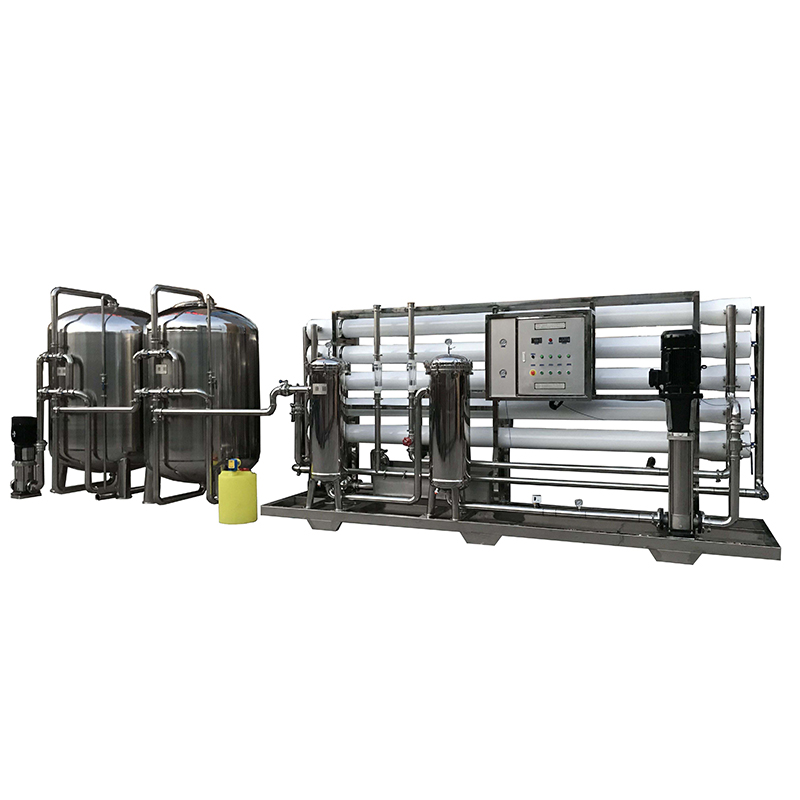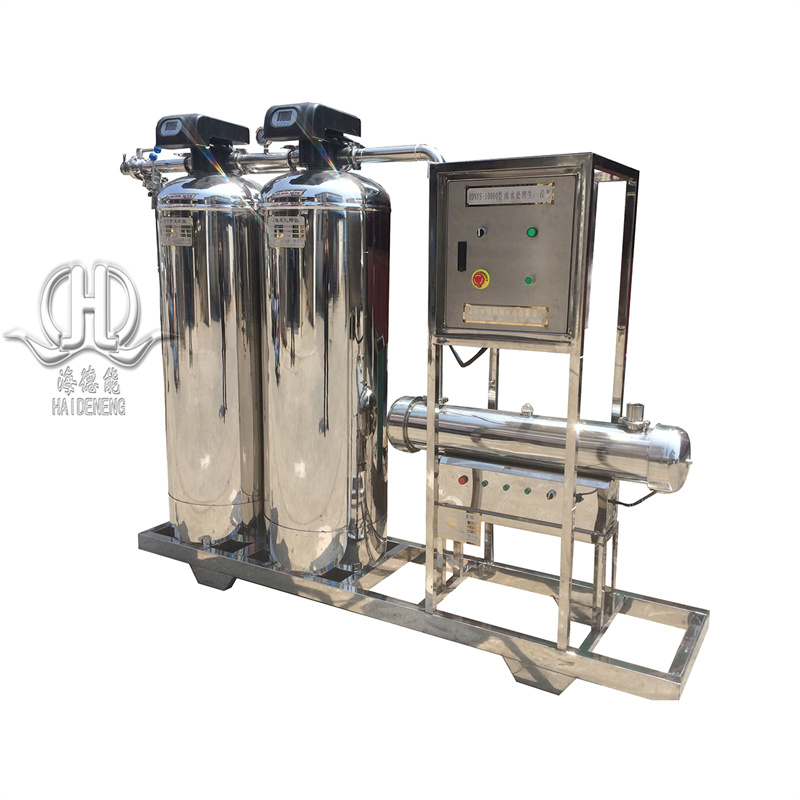Sand filter, carbon filter, belt softener, fully automatic reverse osmosis water purification system
Product description
Technical analysis of sand filtration, carbon filtration, and fully automatic reverse osmosis water purification system with softening
1、 System core architecture and process flow
The water purification system achieves the conversion of raw water from turbid water to pure water through a three-stage process of “pretreatment softening desalination”. The core process is as follows:
plaintext
Raw water → sand filter → carbon filter → softening device → precision filter → fully automatic reverse osmosis (RO) device → produced water
System functions:
Pre treatment stage (sand filtration+carbon filtration): remove suspended solids, colloids, organic matter, and residual chlorine;
Softening stage: Reduce water hardness to prevent scaling of RO membrane;
Desalination stage (RO): Deeply remove dissolved salts and produce high-purity water.
2、 Technical principles and parameters of each unit
1. Sand Filter
Principle: Quartz sand (particle size 0.5-1.2mm) is physically intercepted and deeply filtered to remove large impurities such as sediment and rust from raw water, reducing turbidity from 20NTU to ≤ 5NTU.
Automated control:
Pressure difference triggers backwashing (>0.05MPa) or timed (8-12 hours), with a backwashing intensity of 15-20L/(m ² · s), lasting for 5-10 minutes;
The backwash water source comes from produced water or raw water, saving water resources.
2. Carbon Filter
Principle: Coconut shell activated carbon (specific surface area ≥ 1000m ²/g) removes residual chlorine (removal rate>99%), organic matter, and color and odor through physical adsorption (van der Waals force) and chemical adsorption (surface functional group reaction).
Key parameters:
Contact time 10-15 minutes, residual chlorine in effluent ≤ 0.05mg/L, COD removal rate 40% -60%;
Activated carbon filling density is 800-1000kg/m ³, with a replacement cycle of 1-2 years.
3. Softener device
Principle: Na type ion exchange resin reduces water hardness from 300mg/L (calculated as CaCO3) to ≤ 5mg/L through ion exchange reaction (2R Na+Ca ² ⁺ → R ₂ – Ca+2Na ⁺).
Operating parameters:
Resin exchange capacity of 1.8-2.0mol/L, regenerated salt consumption of 80-100g/L resin;
Regeneration cycle: triggered by flow rate (for every 100m ³ of water processed) or time (72 hours), with a regeneration time of approximately 90 minutes.
4. Fine Filter
Function: The 5 μ m PP melt blown filter element intercepts fine particles and colloids remaining after pretreatment, ensuring that the influent SDI is ≤ 5 and protecting the RO membrane.
Maintenance logic: If the pressure difference is greater than 0.1MPa or the filter element needs to be replaced after 1-3 months of operation, the quick opening structure is easy to operate.
5. Fully automatic reverse osmosis device (RO)
Principle: Under a pressure of 0.8-1.5MPa, water molecules pass through the RO membrane (pore size 0.0001 μ m), intercepting impurities such as salt and bacteria, and achieving a desalination rate of ≥ 95%.
Core parameters:
Membrane element: Aromatic polyamide composite membrane, with a single water production rate of 0.5-1m ³/h;
Recovery rate: 60% -80%, water conductivity ≤ 50 μ S/cm (when the TDS of the raw water is less than 2000mg/L);
Automation: PLC controls start stop and flushing (low-pressure flushing for 1 minute when starting up, chemical flushing for 5 minutes when stopping), and real-time monitoring of excessive conductivity emissions.
3、 Progress of water quality and treatment effect
Turbidity (NTU), residual chlorine (mg/L), hardness (CaCO3, mg/L), conductivity (μ S/cm), and bacterial retention rate during the processing stage
Raw water ≤ 20 ≤ 1.0 ≤ 500 ≤ 2000 None
After sand filtration, ≤ 5 ≤ 0.5 ≤ 500 ≤ 1800 30% -50%
After carbon filtration, ≤ 3 ≤ 0.05 ≤ 500 ≤ 1500 50% -70%
Softened ≤ 3 ≤ 0.05 ≤ 5 ≤ 1500 50% -70%
Precision filtration ≤ 1 ≤ 0.05 ≤ 5 ≤ 1500 70% -90%
RO water production ≤ 0.5 ≤ 0.02 ≤ 1 ≤ 50 ≥ 99.9%
4、 Technological advantages and innovative design
Fully automated collaborative control
Sand filter/carbon filter backwashing and softening regeneration are executed in a staggered manner to avoid sudden drops in system flow;
The RO device is linked with the pre-treatment, and automatically suspends the RO operation when the hardness of the softened water exceeds the standard to prevent membrane fouling.
Anti pollution and long-life design
Pre treat with three-stage filtration (sand filtration+carbon filtration+softening+fine filtration) to extend the RO membrane fouling cycle to 6-12 months;
Softening resin adopts countercurrent regeneration technology, reducing salt consumption by 15% compared to the industry average, and the resin life can reach 3-5 years.
Energy saving and environmental optimization
Variable frequency control of high-pressure pump: energy consumption of 1.5-2kWh/m ³, saving 20% energy compared to traditional systems;
Concentrated water reuse: When TDS<1000mg/L, it can be reused for green irrigation, and the water resource utilization rate can be increased to over 85%.
5、 Application scenarios
Industrial production water
Electronic semiconductor: chip cleaning water (conductivity ≤ 10 μ S/cm), matched with EDI production of ultrapure water;
Pharmaceutical industry: Preparation of purified water (compliant with GMP standards) for use in formulations and equipment cleaning;
Power industry: Boiler feedwater (hardness ≤ 0.03mmol/L) to prevent scaling and corrosion.
Civil and Municipal Scenarios
Direct drinking water system in residential areas: water conductivity ≤ 50 μ S/cm, equipped with ultraviolet sterilization, supporting pipeline quality water supply;
Rural drinking water renovation: treating high hardness and high turbidity groundwater to solve scale and microbial problems.
Special fields
Laboratory water: used as a basic equipment for pure water (later compatible with ultrapure water machines);
Offshore platform: Pre treatment of seawater desalination (requiring sand filtration and carbon filtration to remove suspended solids and residual chlorine).
6、 Maintenance and troubleshooting
Component maintenance content cycle
Check the loss of filter material in sand/carbon filters, replenish/replace sand filters every six months, and replace carbon filters every year
Softening resin testing exchange capacity, regeneration/replacement every 2-3 years
RO membrane element chemical cleaning (citric acid+sodium hydroxide) every 6-12 months
Replace the filter element of the precision filter every 1-3 months
Common troubleshooting:
RO water production decreases: When the membrane is contaminated, clean it with a 2% citric acid solution, and increase the inlet water temperature to 25 ℃ when it is low;
Softened water hardness exceeds the standard: resin failure requires replacement, and when the concentration of recycled salt is insufficient, it should be adjusted to 8% -10%.
7、 Selection and configuration suggestions
Water production design
Small scale system: 1-10m ³/h (laboratory, small factory), covering an area of 5-10 square meters, with a power of 5-15kW;
Medium sized system: 20-50m ³/h (residential area, food factory), equipped with 50-100m ³ water tank, power 20-30kW;
Large scale system:>100m ³/h (industrial park), multiple sets of equipment connected in parallel, equipped with a central monitoring platform.
Adaptation of raw water quality
High sulfate water quality: The softening device uses sulfate type resin, and scale inhibitors are added before RO;
High silica water quality (SiO ₂>50mg/L): Silicon dispersant is added before RO to prevent silica scaling;
Seawater/brackish water: RO pressure increased to 6-8 MPa, equipped with energy recovery device (such as PX pump).
Industry customized solutions
Food and beverage: The water contact parts are made of 316L stainless steel, which meets FDA standards;
Chemical explosion-proof scenario: Select explosion-proof high-pressure pumps and control cabinets (explosion-proof grade Ex d IIC T6).
summarize
This water purification system achieves deep purification of raw water through the full process design of “sand filtration carbon filtration softening RO”, especially suitable for scenarios with high requirements for water quality stability and automation. Its core value lies in the efficient collaboration of multi-stage filtration, low operation and maintenance costs, and the ability to adapt to different raw water qualities through flexible configuration. It is one of the mainstream solutions for industrial and civilian water treatment.







